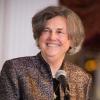A while back, Cardinal Walter Kasper said bishops have two arms: the priesthood and the diaconate. But a few U.S. bishops have interrupted their diaconal formation programs and are not training new candidates during this academic year.
Will there be others? Why now? Can we expect a cadre of one-armed bishops?
Rumors abound that the Congregation for Clergy has asked bishops to evaluate the diaconate in their dioceses -- sooner, rather than later -- and that U.S. bishops are preparing their reports.
Given that nearly half the world's deacons reside in the United States, it's understandable that Roman spyglasses would be pointed at the U.S. Conference of Catholic Bishops.
Why?
Do you think it might be about married clergy? The latest study by the Center for Applied Research in the Apostolate counted 16,921 deacons and 39,466 priests in the U.S. -- slightly fewer total clergy than in 1965. But in 1965, the 58,632 ordained men were priests, only the smallest fraction of them married. Now, factoring in the deacons, nearly one-third of U.S. clerics are married.
Is this a problem?
Shouldn't be. Deacons are ordained to serve the Word, the liturgy and charity. Nobody really cares whether they are married or not, though married men lend an added dimension to the deacon's special (and traditional) role serving as a bridge between the bishop and the rest of the church.
The deacons are – theoretically, at least -- direct representatives of the bishop in the church's ministry of charity. Some have paying parochial or diocesan jobs; some work at Catholic social service agencies or schools. Most have a modest but firm footing in both the secular world and the church.
And deacons living the full charism of the diaconate are among those closest to the suffering church. That defined charism includes carrying the Gospel to the world, both symbolically in the liturgy and in fact in daily ministry. One would think the ministers closest to the church's charity would be the ones to connect it to the words of Scripture.
Well, maybe. Maybe not. Depends on the bishop.
Last June, Bishop Alexander K. Sample of Marquette, Mich., issued a long commentary on the diaconate that includes a letter-of-the law approach to deacons at Mass. It seems he does not want deacons to be regular homilists.
OK. Guess he has a full complement of priests capable of preaching clearly and understandably. Not every diocese is so lucky.
Don't get me wrong -- I am delighted that young priests from India and Africa and elsewhere have the opportunity to serve for a few years in the United States.
But give us a break. Too many of these men are incomprehensible.
Then there is the culture barrier. I once heard a non-American priest give a rambling lecture-homily about the "place" of women in society that was so bad the parishioners who stayed tried to clap him quiet.
Bottom line: If it's between a U.S. deacon and a foreign priest who can't speak clearly and knows nothing about local culture or customs, I'd rather listen to the deacon, thank you.
Fact of the matter is, we need more deacons. But along with Bishops Robert J. McManus (Worcester, Mass.) and William F. Murphy (Rockville Centre, N.Y.), and perhaps one or two others, Marquette's Sample has postponed the formation and training of a new class of deacons.
Whatever happened to the new evangelization? Don't we need new evangelists?
Well, on the one hand, it makes perfect sense for a bishop here or there to regroup and take stock. The rejuvenated diaconate is relatively new, and maybe needs a tune-up in some places.
On the other hand, the long arm of the Congregation for the Clergy reaching across the ocean to page through diocesan files raises other questions.
Are they afraid of married clergy overtaking the celibates? Are they afraid the church wants to return to its tradition of women deacons? Or do they just want to cancel Vatican II completely?
I think if Rome really wants to understand the diaconate -- for men and for women -- the history books tell the story of then and now. Modern deacons are the same as those in the early church: servant-leaders who carry forth the bishop's charity with particular attention to the poor and marginalized. They properly proclaim the Gospel, and sometimes they are the clerics best qualified to preach.
The whole church can hope the redaction of the diaconate in a few dioceses is just a temporary local course correction, not the beginnings of a sepsis attacking the church's ministry of charity. The diaconate is not only one of the bishop's arms; according to the third-century Didascalia apostolorum the deacon is "the ears, mouth, heart and soul of the bishop" as well.
That's a lot for a bishop to lose.
[Phyllis Zagano is senior research associate-in-residence at Hofstra University and author of several books in Catholic studies. Her most recent books are Women & Catholicism, published by Palgrave-Macmillan in June, and Women Deacons: Past, Present, Future (with Gary Macy and William T. Ditewig) newly released by Paulist Press.]
Editor's Note: We can send you an e-mail alert every time Phyllis Zagano's column, "Just Catholic," is posted to NCRonline.org. Go to this page and follow directions: E-mail alert sign-up. If you already receive e-mail alerts from us, click on the "update my profile" button to add "Phyllis Zagano" to your list.


